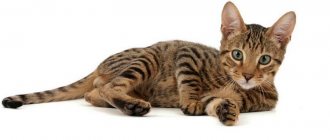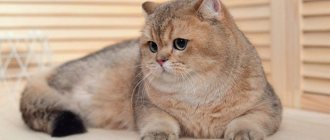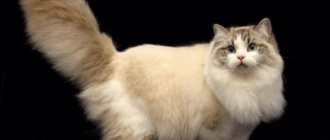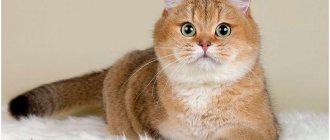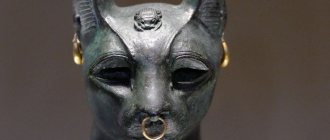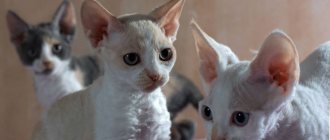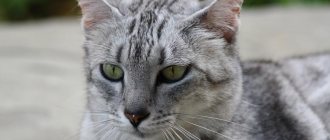The gorgeous golden color of these cats and their soft plush coat are eye-catching. For those who are interested in the breed and are already thinking about finding a kitten, it is worth mentioning that the golden chinchilla (golden chinchilla) is a color that is found in several cat breeds.
British golden chinchilla (BRI-ny12)
A little about the appearance of the precious rock
The first birth of a chinchilla cat occurred in the 80s. 19th century in America. A simple smoky cat and a silver tabby gave the world beautiful babies with iridescent gray fur, who were given the name chinchilla.
This unique coat color instantly found its fans, and later the breeders worked with inspiration so that in addition to the silver chinchilla, a golden chinchilla would be born.
The painstaking work bore fruit already in the 30s. In the 20th century, the number of chinchillas increased, thereby securing the result obtained. At the same time, the golden chinchilla cat breed is born less often, and therefore is valued an order of magnitude higher.
The history of the golden chinchilla
For the first time, golden kittens appeared in a litter from two Persian cats of silver chinchilla color. The spectacular fur coat immediately attracted the interest of breeders. It has not yet been possible to find the gene for golden color. Genetics have put forward a theory about a group of genes that provide additional synthesis of yellow pigment. This assumption is too vague, but satisfactory. Today, various types of bindings are used to obtain, improve and secure gold. They continue to breed two silver chinchillas, breed golden ones “in themselves” and experiment with other colors.
The golden chinchilla color first appeared and was standardized in Persian cats.
Soon British and Scottish breeders wanted a new color, and they began breeding their cats with Golden Persians. Gold looked very beautiful on a short plush coat, work on fixing the color in these breeds went even faster, and golden Britons became very much in demand. Today, many people associate the golden chinchilla color with the British Shorthair cat, although it can also be found in any other breed for which the silver chinchilla color is recognized and possible.
The use of Persian cats with such a seductive color made it possible to obtain it from British and Scottish cats.
Excellent appearance
Initially, the chinchilla color was applied exclusively to Persian cats, but from about the end of the 1970s. it is used to name British and exotic purrs. Despite belonging to different breeds, chinchilla cats have similar external characteristics:
- Weight – cat – up to 5 kg, cat – up to 7 kg.
- Body – has a compact size with a straight back and a broad, raised chest. The overall lines and contours of the body are beautiful and soft.
- The head is small in size, the skull protrudes slightly, the jaws are clearly visible. The distance between the rounded ears is large.
- The nose is upturned and short. The lobe can be soft pink or a darker, brick color, with a dark outline running along the contour.
- The eyes are located far from each other and are rather large in size. There must be dark eyeliner edging the eye. The shade is deep and rich, matching the tone of the coat. The golden chinchilla has green eyes, and in rare cases copper eyes.
- The paws are powerful, rounded and short. The pads are dark in color and have tufts of hair between the toes.
- The tail is well-furred and straight, with longer hair than on other parts. The size is short.
- The hair of Persians is long, fluffy and thick; the British will have it shorter, but also thick and very dense.
- Golden color is a rare combination of two shades. The golden apricot coat is combined with a darker, light chocolate undercoat, which stands out brightly on the paws, head and tail. Also, unlike silver chinchillas, golden ones do not have black eyeliner, but dark brown.
Description of the breed and requirements for the standard
According to the golden chinchilla standard, there is a lack of uniformity. They are assessed in accordance with the rules created for the respective cat breed. Therefore, for example, Persian and British representatives will have their own breed characteristics.
The golden chinchilla of the British breed is massive, muscular and compact in size. These cats are medium to large in size. The animals' limbs are squat and dense, and their paws are rounded.
The tail is short, quite thick and curved upward. British chinchilla cats have a plush coat, outwardly dense rows of fine hairs should make up a coat with iridescence.
The head of these representatives is round and very massive, and the neck is short and muscular. The muzzle has a well-prominent chin and a straight nose. These cats are distinguished by widely spaced emerald eyes and spread round ears.
The presence of two subtypes distinguishes the Scottish chinchilla cat. The first version of the Scottish Fold is distinguished by the fact that the tips of its compact ears are inclined forward and downward. This variety is also notable for its thicker cheeks and short, thick legs. Another type of Scottish Straight has medium-sized limbs, as well as ears, which are larger than those of Scottish Fold cats.
Character
The chinchilla cat breed of any coat color variation has a wonderful character, but there are differences between the breed variants.
The Persian chinchilla is an extraordinary and charming purr that loves to explore everything. Her playful disposition will be loved by her equally energetic and cheerful owners, to whom she becomes quite attached and can lie on someone’s lap for hours.
It is very important to give your pet some of your free time - different games with paper bows, toy mice and bones will cheer everyone up and protect the purr from obesity.
The smallest members of the household will find a wonderful play partner in the face of the Persian chinchilla. But the cat will not give in to all the child’s whims and will simply leave at the right moment. The purr will not offend the baby.
The chinchilla Persian rarely finds common ground with other pets - such a wayward aristocrat.
The British chinchilla cat breed has a different character. This sophisticated lady is affectionate, calm and very talkative. Happy purring and meowing is her method of communicating with her household.
But at the same time, British chinchillas value their personal space. They will not lie in the owner’s arms for a long time, allowing themselves to be squeezed. In general, this cat does not favor excessive tenderness.
As for training, the British chinchilla easily masters the established rules and, with a special approach, can master basic commands. Her intelligence level is above average; the main thing is that the mannered pet is in the right mood.
The Golden Briton socializes very quickly and no aggression is observed in her behavior. He treats strangers and children calmly, but is a little cautious. She sees other animals as competitors in her place, so she simply ignores them.
One color, gold, but the differences between British and Persian women are significant.
Care
Any chinchilla needs proper care:
- Grooming. Both Persians and British Shorthairs need to be brushed twice a week using a Furminator. First they go through the hair growth, and then vice versa. During molting, pets are combed daily. At the same time, Persians need to be examined for the presence of tangles; if they appear, they need to be cut off.
- Face care. Use a damp cloth to clean the muzzle of any dirt. The eyes are wiped with a damp cotton pad (as a preventive measure, instead of water, the swab is moistened with a weak solution of boric acid), and the ears are regularly inspected and cleaned with a cotton swab dipped in Vaseline oil.
- Cat manicure. Claws are trimmed 1-2 times a month. But it is also desirable that the pet has its own secluded corner with a scratching post.
- Water procedures. Chinchillas generally do not like to bathe, so the best solution is to use a suitable dry shampoo.
- Walks. An optional, but still enjoyable event for the cat. The best option is to previously train your pet to wear a harness and use a flea and tick collar. Walking with these two items will keep your pet safe, and the overall process and sense of spaciousness will definitely please him.
Content
- History of the origin of the breed
- Description of the breed Appearance
- Genetics of chinchilla color and its varieties
- Character
- Possible breed defects
- Grooming
- Puberty and first mating
Diet
The golden chinchilla is a cat breed that requires high-quality premium food. There is another option when the pet eats natural food, but with the addition of vitamins.
This natural diet should include the following foods:
- Dietary meat, chicken and offal (necessarily boiled).
- Boiled sea fish (replace meat with it several times a month).
- Soft-boiled eggs (give your pet 2 times a week).
- Low-fat sour milk.
- Vegetables, root vegetables, herbs, cereals and crackers. (mix them with protein foods).
- Pure water
Health
Both British and Persian chinchilla breeds require the attention of their owners. Competent care and thoughtful nutrition in most cases guarantee that a cat will live 12-15 years.
It is very important to regularly take your pet for veterinary examinations, because... There are some diseases characteristic of chinchillas. These are polycystic kidney disease, cardiovascular diseases and retinal atrophy.
It is also necessary to ensure that cats do not develop caries; to do this, accustom your cat to brushing its teeth from early childhood.
Purebred kitten - choose the right one
You should approach the purchase of a golden chinchilla baby responsibly. The price for a show class furry can reach up to $1000. Therefore, choose trusted breeders.
The rare golden color of the chinchilla is highly unstable, so look at the parents of the little miracle. The ideal shade of fur is obtained by mating identical individuals.
Observe the kitten's behavior before purchasing. From an early age they should be active, playful and inquisitive. Healthy babies have clean eyes and ears, and shiny fur.
The baby's parents should also show interest in what is happening, and not lie on one side. Also pay attention to their grooming.
Be sure to talk to the breeder about vaccinations, diet and general health of the baby. Check that you have all the documents and get ready to make your new family member happy.
Where to buy a golden chinchilla kitten
Those who have already finally decided that they want to buy a golden chinchilla should decide on the breed. Will it be a plush intellectual British, a soft and gentle Scottish cat or an independent fluffy Persian.
When searching for purebred kittens, future owners will certainly encounter abbreviations that not everyone understands, for example, BRI ny12 64.
This is how cats are recorded in pedigrees. The first three capital letters indicate the breed: BRI - British; SFL and SFS - Scottish Fold shorthair and longhair, respectively; SCS and SCL - Scottish Straight Shorthair and Longhair, respectively; PER - Persian cat. Next, two small English letters “ny” mean color. N - black and y - gold. The number after them means color variation: 11 - shaded; 12 - chinchilla; 25 - ticked. And the last two digits mean the color of the eyes, which should be green - 64, but can also be blue - 61 or orange - 62.
When they say “golden chinchilla” they often mean cats with one of three color variations: shaded, chinchilla, ticked. They are all noticeably different, but each is golden and beautiful in its own way.
Very few nurseries can boast of truly golden colored kittens. Most babies have what is called an undertone. Before being sold, they are hastily recorded as golden chinchillas, but later they become over-bloomed and the color can change significantly. If a cat is taken for the soul, these nuances are not of significant importance; purity of color is important primarily for breeders.
Price
Advertisements for the sale of golden chinchilla kittens are rare; the most common ones on the market are British golden chinchillas. Their price starts from 25,000 rubles. and does not end at 70,000 rubles. for very valuable specimens. Scottish and Persian kittens cost about the same. For home: 15,000-25,000 rubles, promising for breeding from 35,000 rubles.
